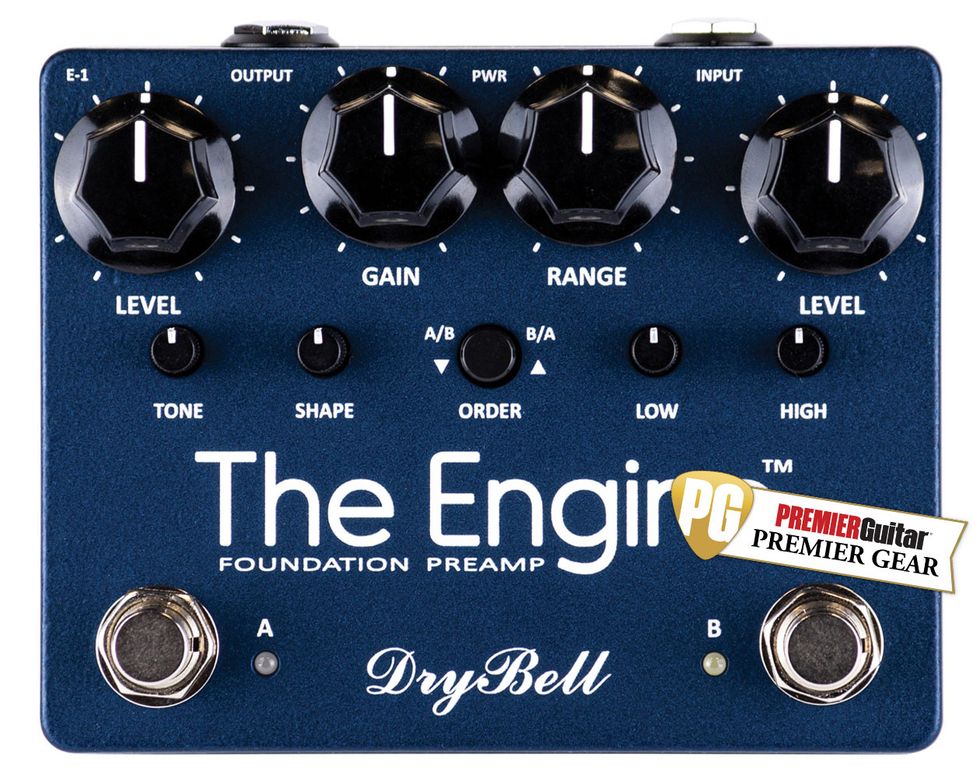Recorded using a Schroeder Chopper TL into a Fender Hot Rod Deluxe IV miked with a Shure SM57 feeding a Focusrite Scarlett going into Logic with no EQ-ing, compression, or effects.
Clip 1: Preamp side, bridge pickup, level at 1 o'clock, gain at noon, tone at noon, shape at 2 o'clock.
Clip 2: Boost side, bridge pickup, range at 2 o'clock, level at 1 o'clock, low at 1 o'clock, high at 11 o'clock.
Clip 3: Both sides engaged. Boost feeding into preamp.
RatingsPros:Big, burly tones with plenty of control. Each effect works great on its own. Cons: Expensive. Street: $299 DryBell The Engine drybell.com | Tones: Ease of Use: Build/Design: Value: |
Here’s a newsflash: Gritty tube-amp distortion sounds really good. Just about any overdrive or boost pedal tries to emulate that cranked-up amp feel. But DryBell’s The Engine is billed as a “foundation preamp,” and that seems to suggest that it’s meant to be as integral as your amplifier to your signal chain. Unlike a lot of pedals that make such claims, The Engine seems up for the task.
The Engine is a two-channel pedal of sorts. Channel A or “side A” as DryBell calls it, is a distortion circuit that takes inspiration from early Marshall designs. Side B is DryBell’s take on a Rangemaster circuit, which we first heard (and loved) in their Unit67 pedal. Naturally, both can be used independently and in either order (more on that in a bit).
Amp Approximations
For my test of The Engine I used a T-style Schroeder Chopper TL and a Fender Hot-Rod Deluxe—which is not a very “British” pairing. But The Engine’s success at making big British sounds with this set up says a lot about how capable it is. Just setting all the knobs at noon makes the pedal sound fantastic. It has a big, burly presence and is rich with the same kind of harmonics that are excited in a loud vintage JTM45. I was also especially impressed with how DryBell handled resonant bass frequencies—a part of the JTM recipe that’s difficult to capture in a pedal. There was plenty of bottom without ever getting flabby, even at more extreme bass settings.
The control setup for side A features three knobs that are typical for a preamp: tone, master level, and gain. But the secret sauce is the shape knob, which loosely approximates the function of a Marshall’s presence knob. It tunes both the mid and treble frequencies and it does an exceptional job of matching the pedal to specific guitars and amps. There’s a lot of extra control in the shape knob, and given that guitars are mid-focused instruments, the additional control of those essential frequencies is a very good thing.
Like any great British-inspired circuit worth its diodes, The Engine is very touch sensitive. Digging in gave me Gibbons-like squeals and harmonics and practically forced me into playing ’70s ZZ Top riffs. The breadth and scope of the gain control was extremely impressive. And while the master tone control might not offer super-minute tonal adjustments, it’s nuanced and powerful enough to re-shape the profile of both single-coils and humbuckers to suit The Engine and whichever amp you use with it.
Treble Boost On Top
DryBell’s excellent Rangemaster-style circuit is the cherry that tops the dessert. By itself, it would be a world-class boost worthy of attention. But combined with side A it’s sometimes too tasty to turn off. The control set for side B offers low and high controls, a level knob, and a range knob, which allows you to choose which mid frequencies to boost.
As with the preamp side of the pedal, I started with knobs at noon to get a feel for the boost’s range and base line. At this setting my basic tone felt bigger and a lot more responsive. As I rotated the range knob I could hear how effectively the sweep control attacks a very specific slice of the EQ profile. If you’ve ever worked with sweepable mid controls, the function and feel of this knob won’t be foreign to you. It’s even more effective thanks to extra space and headroom that the pedal imparts by internally boosting voltage to 23V.
Running the boost into the distortion sounds glorious. When combined, each knob retains its integrity and sense of space. And let me tell you, this preamp is loud. It might be one of most powerful and robust gain circuits I’ve ever played.
The Verdict
The Engine is a combination of good design, a keen ear for vintage sound and dynamics, and considerable thought for how a modern player might use these tones. Both effects are outstanding, but combined they take the amp-in-a-box to a higher level. If you’re a meat-and-potatoes player who likes your sounds straight-ahead sand in your face, The Engine might be all you need to run your rig.









![Rig Rundown: Russian Circles’ Mike Sullivan [2025]](https://www.premierguitar.com/media-library/youtube.jpg?id=62303631&width=1245&height=700&quality=70&coordinates=0%2C0%2C0%2C0)

















